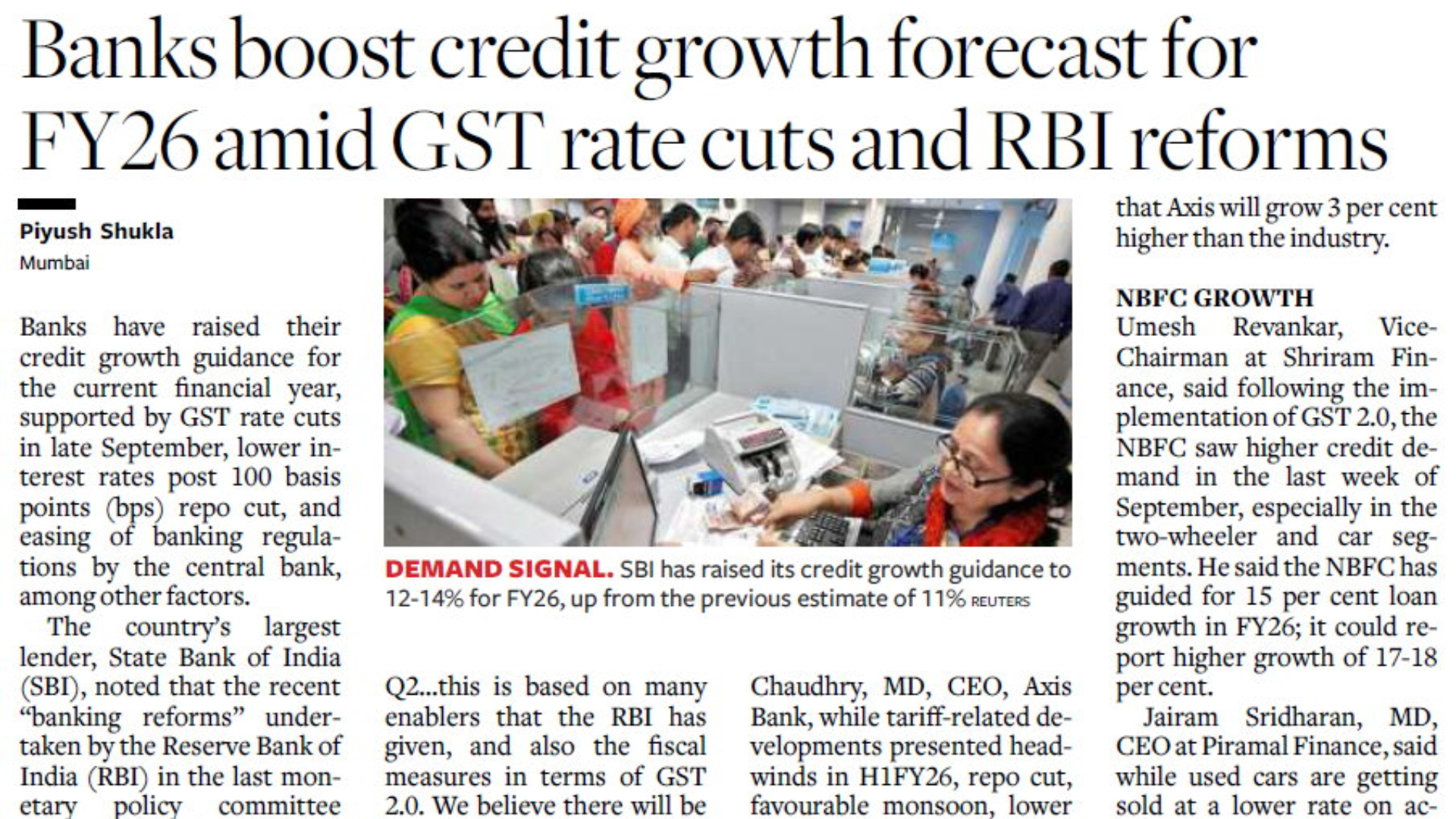Banks Raise Credit Growth Guidance on GST Cuts, Rate Easing, and RBI Reforms
India’s leading banks have raised their credit growth forecasts for FY26, buoyed by a combination of monetary easing, GST rate cuts, and regulatory relaxation by the Reserve Bank of India (RBI). The consensus across the banking sector is that demand for loans will accelerate, especially in the retail, agriculture, and MSME (RAM) segments, as the economic momentum strengthens.
The country’s largest lender, State Bank of India (SBI), has called the RBI’s latest policy actions “credit accretive,” reflecting confidence in the post-reform lending landscape.
Demand Drivers: RBI and Fiscal Enablers Fuel Lending Growth
“At the industry level, we must see 1 per cent additional credit growth for FY26. We are also revising our guidance from 11 per cent to 12–14 per cent. There is robust growth across business segments in Q2… This is based on many enablers that the RBI has given, and also fiscal measures in terms of GST 2.0,”
He added that SBI witnessed a surge in car and personal loan demand following the GST rate cuts in September, a sign that consumer confidence and affordability are improving.
The repo rate cut of 100 basis points (bps) and the simplified regulatory norms introduced in the RBI’s last monetary policy meeting are expected to further ease credit availability and borrowing costs across industries.
Axis Bank: Macro Tailwinds to Boost H2FY26 Momentum
Amitabh Chaudhry, MD & CEO of Axis Bank, echoed similar optimism, noting that while tariff headwinds affected lending in the first half of FY26, the second half would see strong tailwinds.
“The repo cut, favourable monsoon, lower GST rates, and improving liquidity conditions will enable stronger credit growth. These, combined with the RBI’s progressive policy interventions, are setting the stage for acceleration,”
The remarks reflect a wider sentiment in the private banking space that policy support and macroeconomic stability are beginning to translate into real lending expansion.
NBFCs See Uptick in Retail Demand Post-GST 2.0
The momentum isn’t limited to banks — non-banking financial companies (NBFCs) are also riding the wave.
Umesh Revankar, Vice-Chairman of Shriram Finance, said the implementation of GST 2.0 has led to higher credit demand, particularly in the two-wheeler and car financing segments.
“We have guided for 15 per cent loan growth in FY26, but could end up reporting 17–18 per cent, given the pickup in auto and small business lending,”
Similarly, Jairam Sridharan, MD & CEO of Piramal Finance, said that while used car prices have softened due to lower GST, the increase in unit sales is offsetting the impact.
“Our AUM growth guidance is 25 per cent for the fiscal year… Currently, we are trending meaningfully above what we anticipated at the beginning of the year,”
A Broad-Based Lending Revival
Across the financial ecosystem, lenders are witnessing renewed credit appetite from retail borrowers, MSMEs, and urban consumers — aided by lower borrowing costs, improved liquidity, and tax rationalisation.
The synchronized optimism between public sector banks, private lenders, and NBFCs signals a broader credit revival that could lift India’s growth trajectory through FY26 and beyond.
If these trends hold, the coming quarters could mark a turning point for credit expansion, particularly in consumption-driven and MSME segments, which remain central to India’s economic recovery.
For expert insights on how RBI reforms, fiscal policy changes, and credit cycles are shaping India’s financial ecosystem, read analysis by Ranjit Jha (CEO) — a market strategist and authority on banking-sector trends and economic policy.
To explore how these lending tailwinds could influence investment opportunities and portfolio allocation, connect with Rurash Financials — specialists in wealth management, credit analytics, and market-linked investment strategies.

